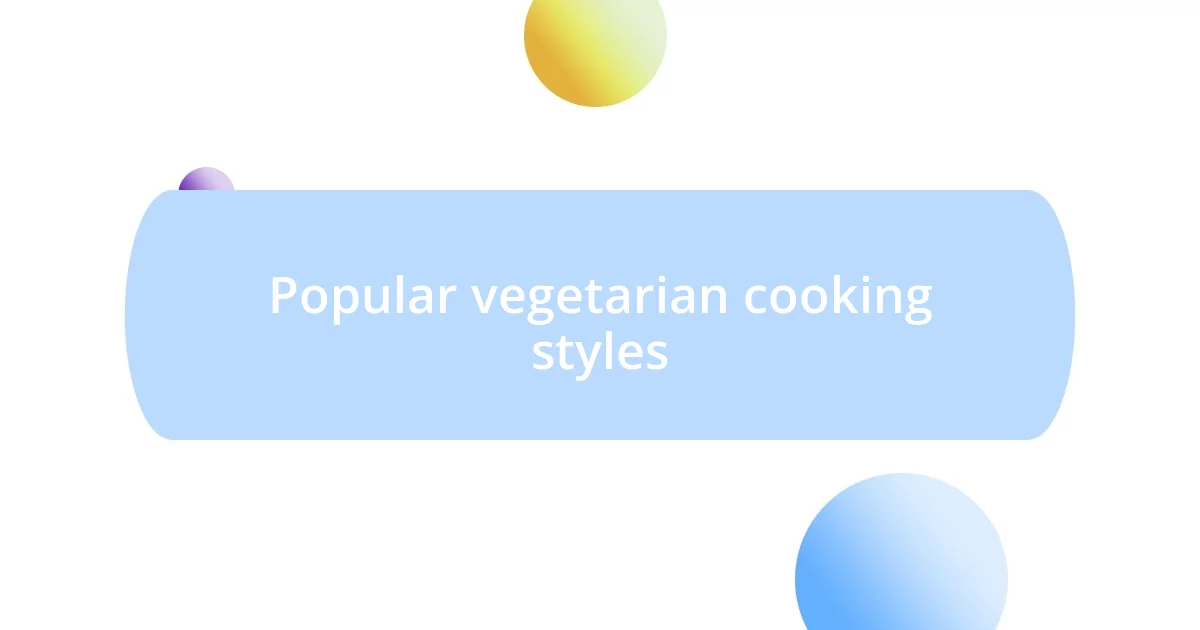Key takeaways:
- Highlighted favorite vegetarian cookbooks include “Plenty” by Yotam Ottolenghi, “The Moosewood Cookbook” by Mollie Katzen, and “Thug Kitchen,” each offering unique styles and flavors.
- Essential features of great cookbooks include personal stories, clear instructions with photos, and inclusivity for various dietary needs.
- Engaging with online communities and exploring seasonal recipes enhances the vegetarian cooking experience, offering support and connection while celebrating fresh, local ingredients.

Top vegetarian cookbook recommendations
One of my all-time favorites has to be “Plenty” by Yotam Ottolenghi. The recipes are vibrant and bursting with flavor, and I love how they incorporate unique ingredients like pomegranate molasses and tahini. Every time I flip through its pages, I’m inspired to try something new—like, do you ever think about how just one ingredient can completely transform a dish?
Another gem in my collection is “The Moosewood Cookbook” by Mollie Katzen. It’s like a comforting hug in book form, filled with wholesome recipes that evoke nostalgia for the time I first attempted to make their famous vegetable lasagna. How can you not feel good about cooking when you see to recipes that seem to reflect love and care in every bite?
Lastly, “Thug Kitchen: The Official Cookbook” always brings a smile to my face with its fun, irreverent style. Sometimes, I need that burst of energy in my kitchen—do you feel the same way? Its straightforward approach and humor make cooking feel less like a chore and more like an adventure. I appreciate how it doesn’t shy away from the messiness of life, encouraging everyone to get their hands dirty while making something delicious.

Essential features of great cookbooks
Cookbooks that stand out to me often have a few essential features that distinguish them from the rest. For instance, well-written introductions to each recipe can set the tone and make the experience feel more personal. I remember flipping through a beautiful cookbook where the author shared a heartfelt story about a family gathering that inspired each dish. That connection turned a simple recipe into a treasured memory I wanted to recreate in my kitchen.
Another critical aspect is clear, detailed instructions accompanied by enticing photographs. I’ve found that when I can visualize the end result, I’m much more likely to try my hand at a new recipe. Just the other day, I followed a recipe that showcased a stunning presentation of a salad. Seeing that vibrant photo made me not only hungry to eat it but also excited about putting in the effort to craft something equally beautiful.
Lastly, inclusivity in dietary needs is something I always look for. A great cookbook doesn’t just cater to vegetarians; it should also consider those with gluten-free or nut-free requirements, making it accessible for everyone at the table. I once had a friend over for dinner who was gluten intolerant; I felt relieved to pull a recipe from a trusty cookbook that offered thoughtful substitutions. Thankfully, that meal was a hit, and it made my friend feel included in the culinary experience.
| Feature | Importance |
|---|---|
| Personal Stories | Enhances connection and engagement |
| Clear Instructions and Photos | Encourages experimentation and reduces anxiety |
| Inclusivity for Dietary Needs | Makes the cookbook accessible to a wider audience |

Popular vegetarian cooking styles
Vegetarian cooking styles are as diverse as the ingredients we use. I find that exploring different cuisines opens up a treasure trove of flavors and techniques. For instance, Indian cooking is a spectacular vegetarian option, filled with aromatic spices and vibrant dishes. I still remember the first time I made chana masala; the smell of cumin and coriander wafting through my kitchen was absolutely intoxicating. It’s a reminder of how spice blends can transform simple legumes into something magical.
Another wonderful style is Mediterranean cooking, celebrated for its fresh ingredients and heart-healthy fats. I often gravitate toward dishes featuring olive oil, fresh vegetables, and herbs. A simple roasted vegetable platter drizzled with a good balsamic reduction can make for an amazing meal or side. Plus, I find that incorporating these fresh elements not only nourishes my body but also my soul, evoking sunny afternoons spent by the sea.
- Indian: Rich in spices, offering dishes like chana masala and dal.
- Mediterranean: Focuses on fresh vegetables and healthy fats, featuring dishes like tabbouleh and roasted vegetables.
- Asian: Incorporates ingredients like tofu and rice noodles, often found in stir-fries and curries.
- Mexican: Vibrant flavors from black beans, corn, and chili peppers, perfect for veggie tacos and enchiladas.
- American: Contemporary recipes can transform classic comfort foods into delicious vegetarian versions, like lentil burgers and cauliflower wings.

Resources for meal planning
When it comes to meal planning, I’ve found that utilizing digital resources can be a game-changer. Websites like Mealime or Plan to Eat allow you to customize your weekly menu, making it easier to incorporate a variety of vegetarian ingredients. I remember when I started using one of these platforms; it felt fulfilling to structure my meals around seasonal produce, helping me eat fresher and waste less.
I’ve also embraced the power of Pinterest for meal inspiration. It’s like a virtual cookbook where you can curate your favorite vegetarian recipes on boards. One evening, while browsing, I stumbled upon a stunning recipe for a roasted vegetable grain bowl that perfectly aligned with my desire to balance flavors and textures. I often wonder how I ever managed without such visual tools—they bring your meal ideas to life and spark creativity in a way that’s incredibly motivating.
Of course, traditional resources still hold a special place in my heart. I often reference meal prep guides from my favorite cookbooks. They often provide detailed plans for batch cooking, which has saved me countless hours in the kitchen. Just the other weekend, I prepped a week’s worth of lentil soup and quinoa, giving me nutritious meals ready to go at a moment’s notice. Have you ever felt that satisfaction from knowing your meals are set for the week? It’s truly liberating!

Tips for ingredient substitutions
When experimenting in the kitchen, I’ve learned that ingredient substitutions can often lead to delightful surprises. For example, if I’m out of eggs, I’ve found that mashed bananas or flaxseed meal mixed with water can serve as terrific binders in baked goods. The first time I tried this, I was pleasantly surprised at how moist the banana bread turned out—who knew a simple swap could create something so delicious?
When it comes to dairy, I often replace heavy cream with coconut milk or cashew cream. I remember whipping up a creamy pasta dish with coconut milk and being amazed by the subtle sweetness it added. Never did I think a dairy-free alternative could elevate a meal to new heights! Plus, I can’t help but wonder—if we can enjoy these swaps, what else might we be missing out on by sticking strictly to traditional ingredients?
Don’t underestimate the power of herbs and spices as substitutes for more conventional flavorings. For instance, if I run out of fresh herbs, I’ll reach for dried ones—as a rule of thumb, I use about one-third the amount of dried herbs as I would fresh. This practice has saved me more than once when I’ve been in a pinch. Have you ever experimented with what you have on hand? Trust me, you might just stumble upon a new favorite combination that transforms your dish into something special!

Online communities for support
Engaging with online communities has been a transformative part of my vegetarian journey. Platforms like Reddit’s vegetarian subreddits or Facebook groups are treasure troves of support, where you can find recipe inspiration or share tips with like-minded individuals. I remember posting a question about plant-based protein sources when I first switched to vegetarianism. The overwhelming response not only provided me with valuable suggestions but also fostered a sense of belonging that eased my transition.
There’s something undeniably comforting about connecting with others facing similar culinary challenges. In one group, we often participate in themed cooking challenges, which not only push our creativity but also turn cooking into a fun, collaborative experience. I recall the thrill of participating in a “meatless Monday” challenge; the excitement of seeing everyone’s colorful dishes filled my feed with inspiration. Have you ever felt that rush of creativity when you’re surrounded by supportive voices? It’s incredible how a simple challenge can ignite a passion for cooking that you didn’t know was there.
Finding your tribe online can also offer emotional support on tough days. I’ve seen members post about feeling down or struggling with their dietary choices, and the outpouring of encouragement, recipes, and personal stories serves as a reminder that we’re not alone in our journey. When I shared my frustration about a failed vegan cheese recipe, the comforting words and shared experiences flooded in, making me smile and encouraging me to keep experimenting. Isn’t it reassuring to know that a community exists ready to lift you up when things don’t go as planned?

Exploring seasonal vegetarian recipes
Exploring seasonal vegetarian recipes can be a delightful adventure. I’ve discovered that cooking with what’s in season not only enhances the flavors but also connects me to the rhythm of nature. For instance, when summer rolls around, I can’t resist whipping up a vibrant ratatouille bursting with fresh tomatoes, zucchini, and bell peppers. There’s something about using ingredients at their peak that feels almost magical; every bite tastes as if it’s in harmony with the environment.
I remember the first time I harvested fresh herbs from my garden for a fall vegetable stew. The aroma filled my kitchen and stirred up memories of childhood cooking with my grandmother. Using seasonal produce like root vegetables not only warms up my home but also brings a comforting depth to the dish. Have you ever noticed how the seasons influence your cooking? It’s rewarding to create meals that celebrate the bounties of each time of year.
Winter, for instance, brings cozy squash and hearty greens, which I love to blend into warming soups. On particularly chilly days, a butternut squash soup, rich with spices, can feel like a warm hug. I remember serving it to a friend who was feeling under the weather; the joy in her eyes when she took that first sip reminded me of the simple power of food. Don’t you think seasonal cooking feels more fulfilling, knowing you’re not just feeding yourself, but also nurturing your connection to the earth?














